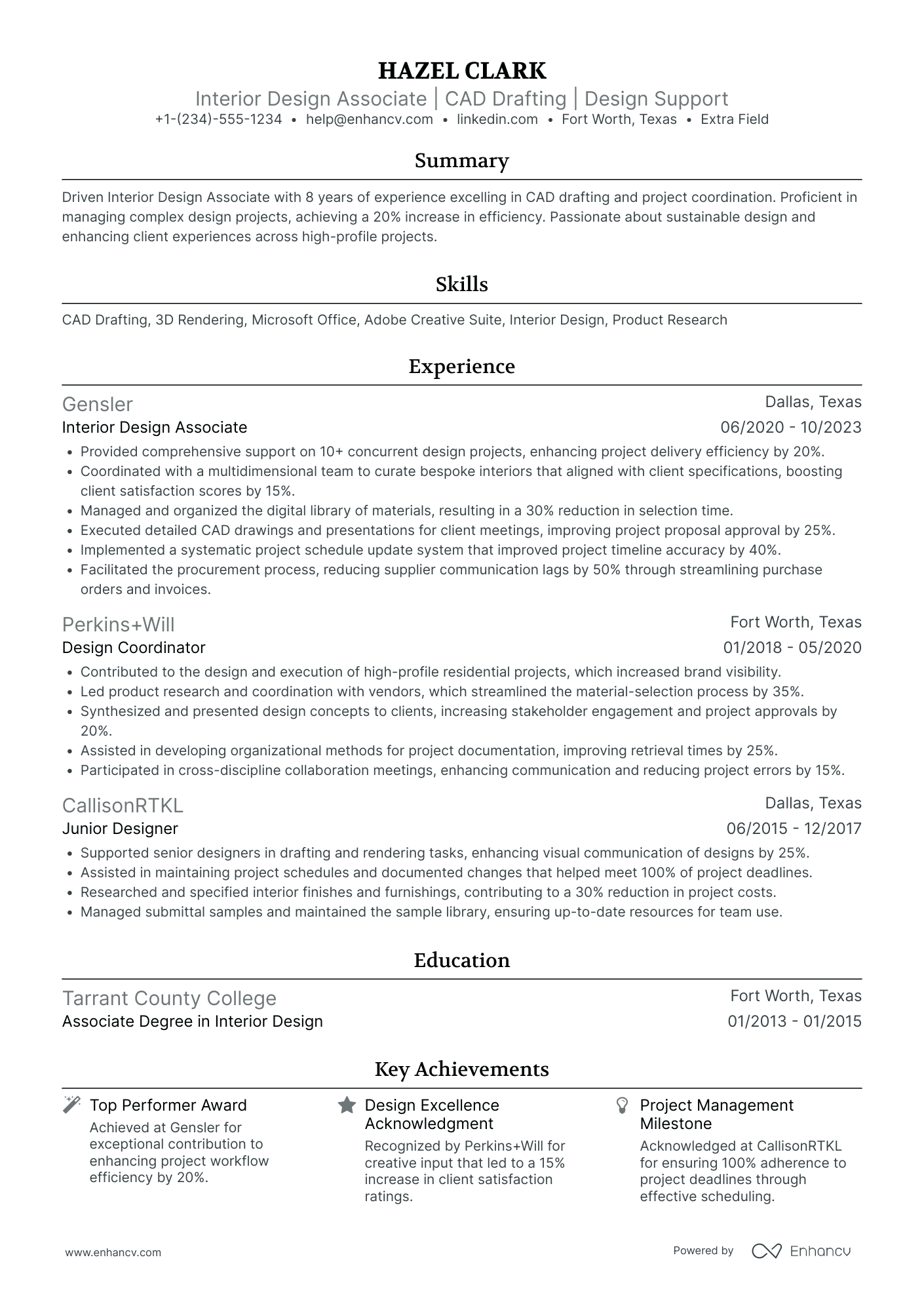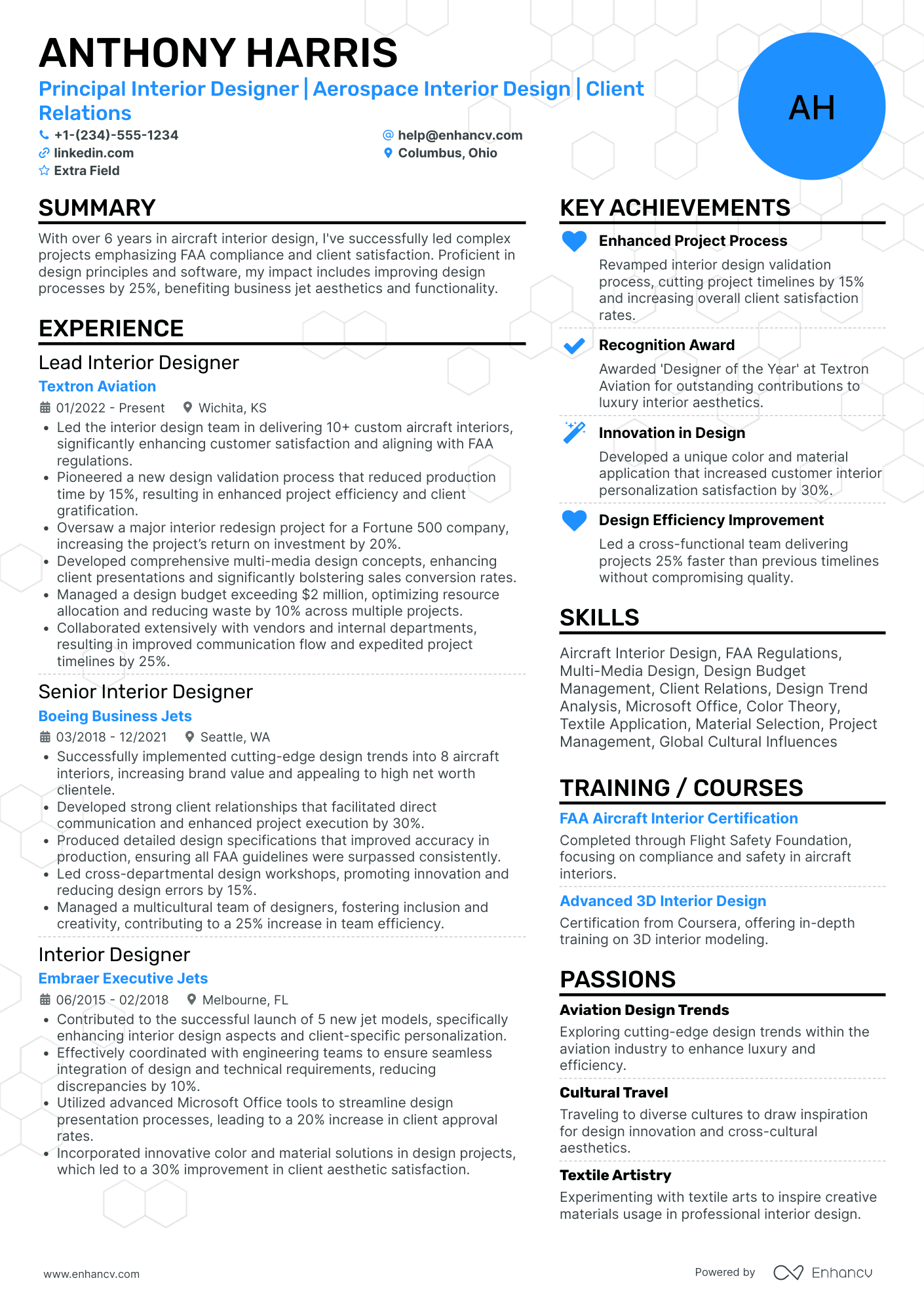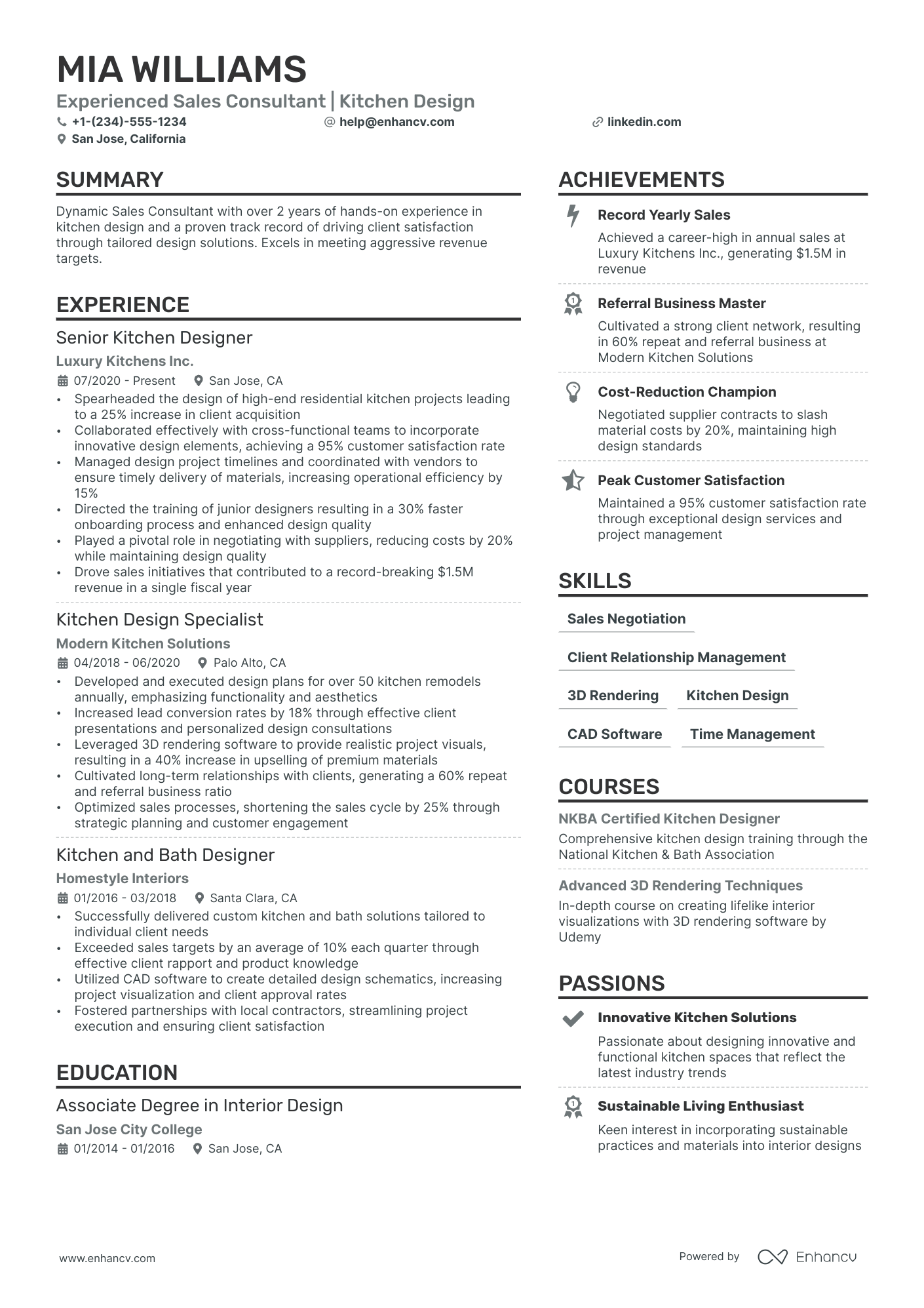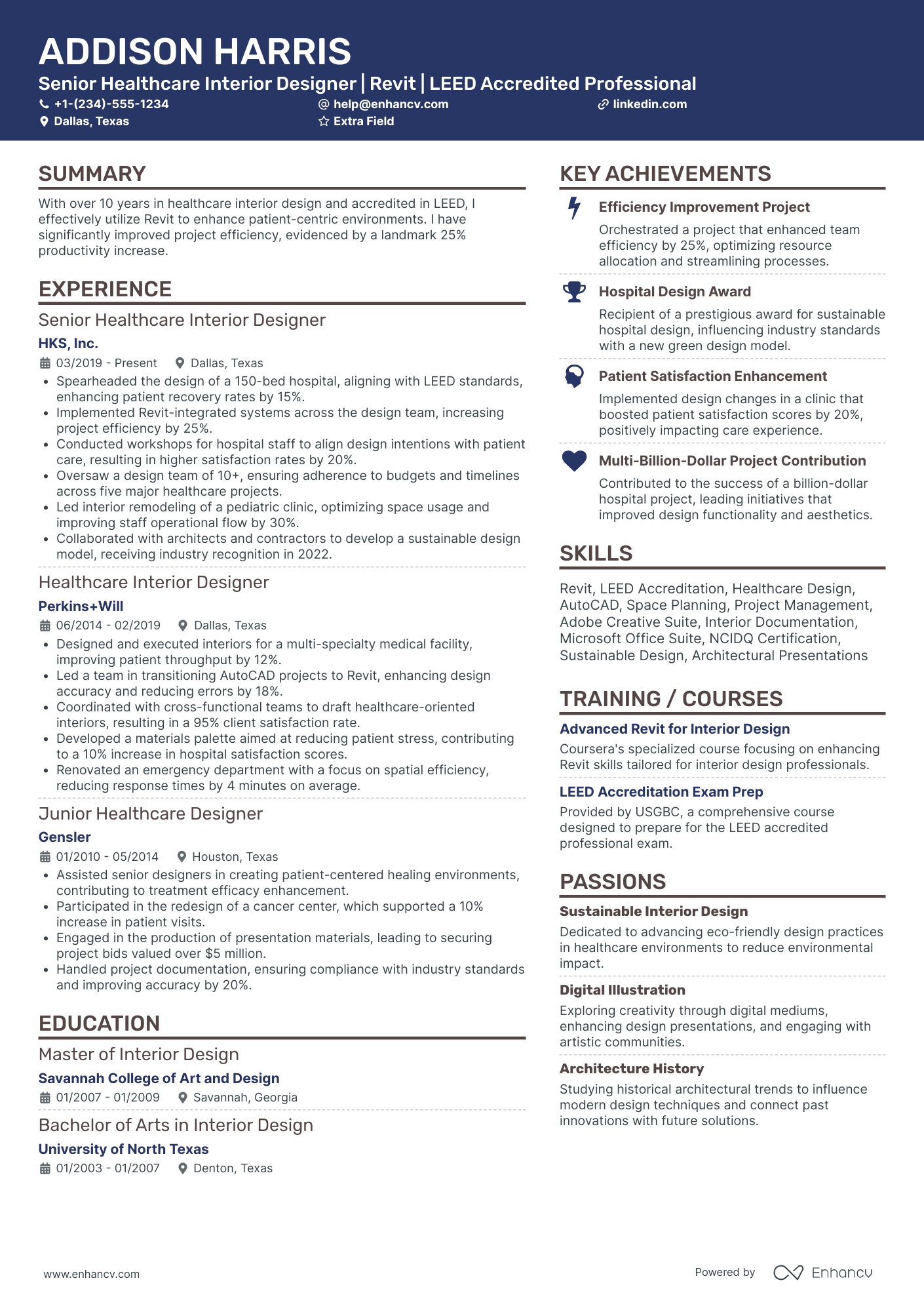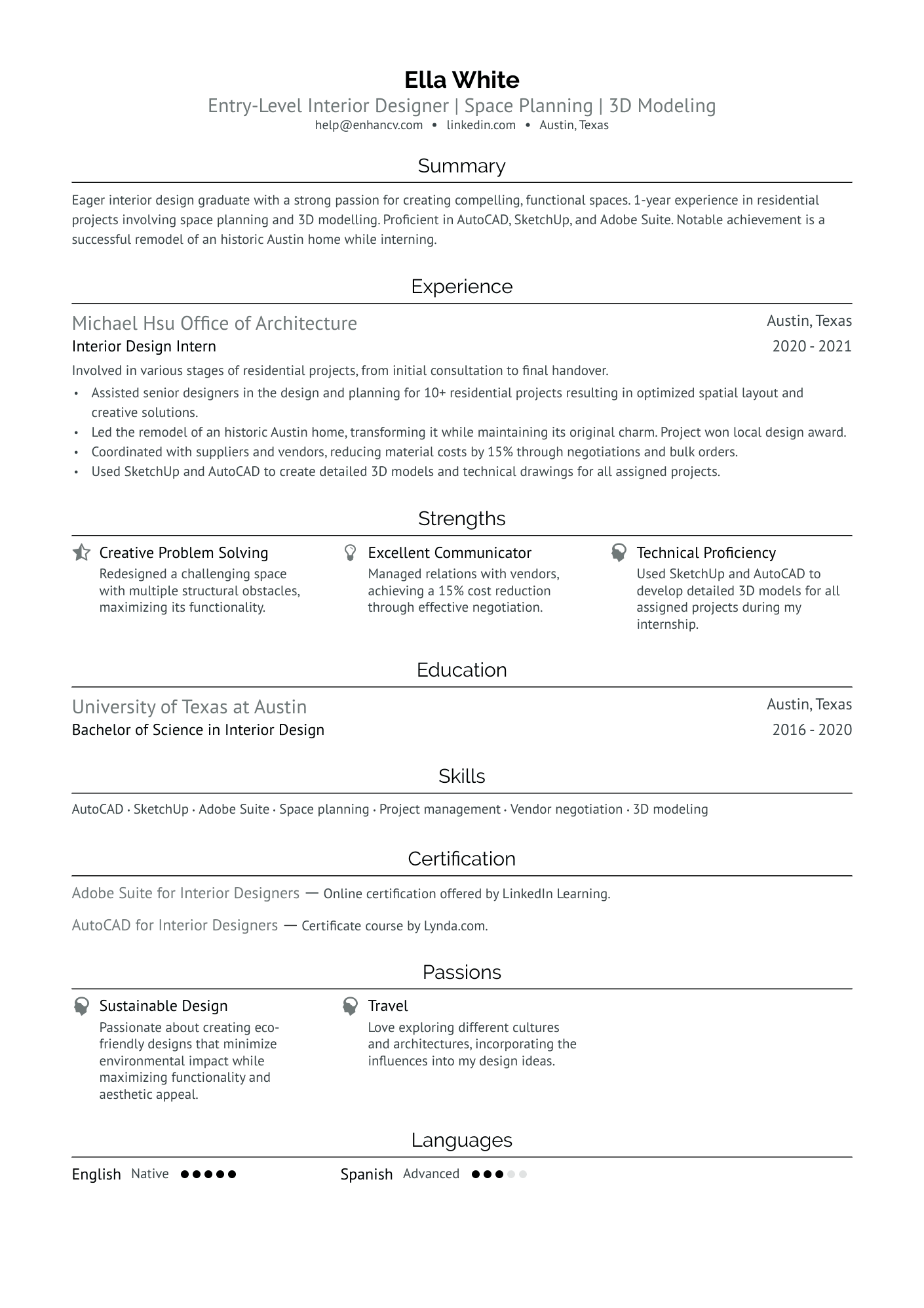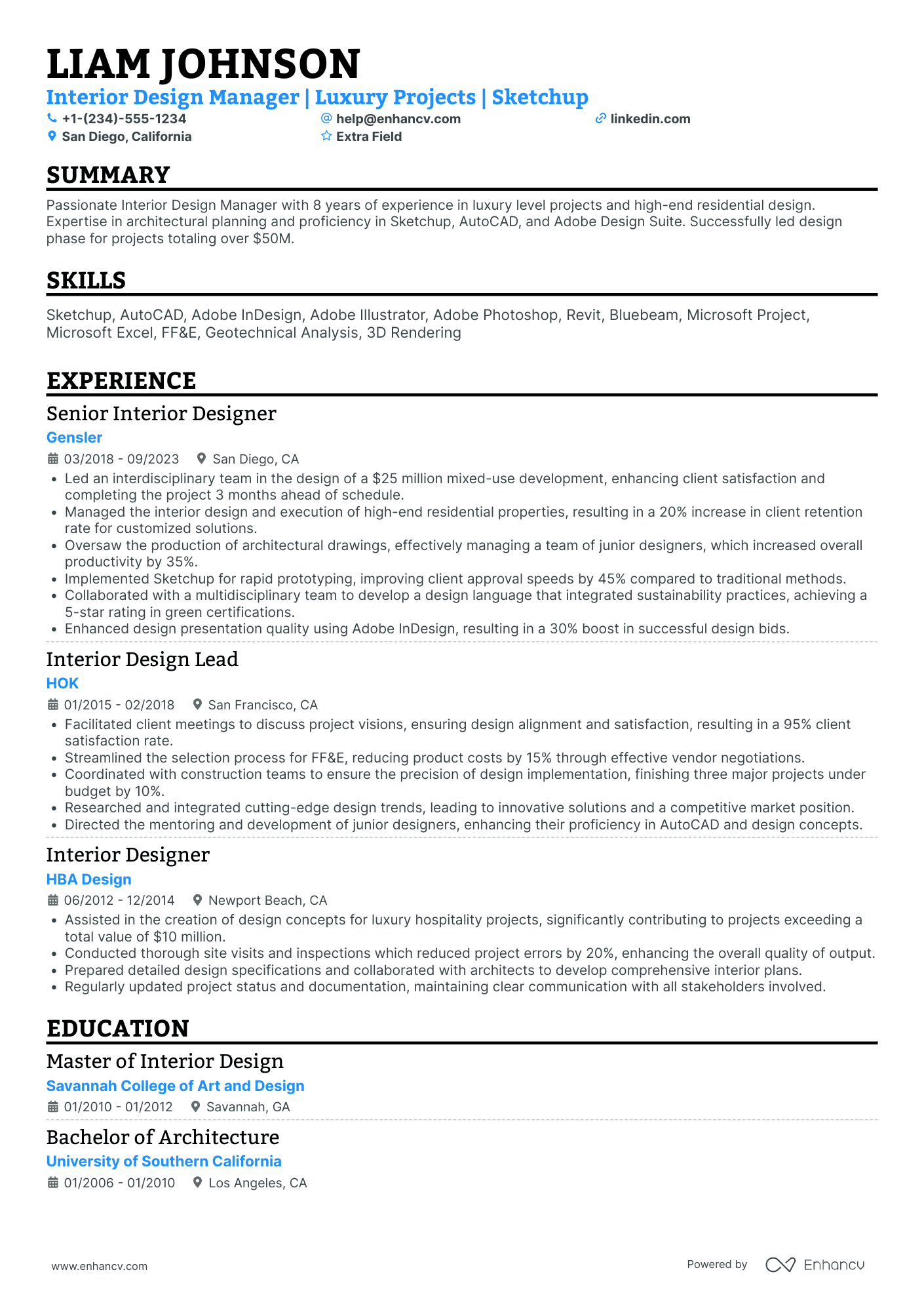Welcome to the world of interior design, where creativity meets functionality, and where your resume is your personal blueprint for success. Just as a well-designed space can transform a room from bland to grand, a carefully crafted resume can open doors in the thriving interior design industry.
But what does it take to design a resume that stands out in this competitive field? Much like a flawless interior plan, it requires a blend of creativity, technical skill, and a keen eye for aesthetics. Whether you're a seasoned professional with a portfolio full of transformations or a fresh graduate looking to color your career, your resume needs to reflect your unique design philosophy and professional prowess.
In this article, we'll help you draft a resume that’s not just functional but also a true reflection of your style and expertise. After all, in the job market, you'll want to make sure your resume is furnished just right to accommodate your career aspirations.
Let's get started on constructing a career canvas that captures your spirit and skillset, ensuring your job application is anything but off-the-shelf.
Here are some of the integral points we’ll go over in the article:
- Resume formats and related tips for achieving the best results.
- The importance of including a portfolio on an interior design resume.
- How to effectively list your employment history and what to do if you lack one.
- Steps and tips on including a rich skills section.
- The best way to display your education and certifications on a resume.
- Understanding the purpose of resume summaries and objective statements.
- Some common problems facing interior design candidates.
- A few additional sections that can be interesting to take advantage of.
If interior design isn’t what you’re looking for, try these other related guides:
The essence of interior design will always be about people and how they live. It’s about the realities of what makes for an attractive, civilized, meaningful environment, not about fashion or what's in or what's out. This is not an easy job.
Renowned interior designer Albert Hadley
The first step to any resume is deciding on which format is right for you. Let’s go through the different options and have a look at some tips to keep in mind while crafting your next resume.
How to format an interior designer resume
Creating the perfect resume as an interior designer is all about making a compelling and organized presentation. Here’s how you can format and design your resume to ensure you shine in the competitive field of interior design:
Resume Formats
- Reverse-chronological format: This is the most traditional and widely accepted format, especially useful if you have a robust history of work in interior design. A reverse-chronological format lists your work experience starting from the most recent job back to the earlier ones. This format is excellent for showing a steady career progression and deepening experience and responsibilities.
- Functional Format: This format focuses on your skills and experiences rather than your job history. It's particularly useful for those who may have gaps in their employment, are changing careers, or are newly entering the field. For an interior designer, the functional format could mean highlighting specific design skills, software competencies, or projects rather than the chronological order of jobs.
- Hybrid Format: A combination of the reverse-chronological and functional formats, the hybrid resume format allows you to showcase your relevant skills at the top of your resume, followed by a reverse-chronological listing of your work history. This format works well for interior designers with a strong set of specific technical skills (like CAD software expertise or a unique design style) and a solid work history that demonstrates these skills in action.
Which one is best for an interior designer?
Although all of the resume formats have their positives, for most interior designers, especially those with some experience or specific skill sets that align closely with the job description, the hybrid format is often the best choice. It allows you to highlight your strongest skills upfront while still providing the chronological context of your work history that employers value.
Remember, resume layouts can vary by country – for example, a Canadian resume format could look different.
A fascinating fact about the interior design industry is its significant contribution to the global economy. The global interior design market is expected to reach an impressive USD 255.4 billion by 2027, growing at a compound annual growth rate (CAGR) of about 7.8% during the forecast period from 2020 to 2027. This growth is driven by increasing consumer interest in home renovation and remodeling, along with the rising demand for attractive yet functional workplace designs, reflecting how both residential and commercial clients are placing more emphasis on the quality of their indoor environments.
Key formatting tips for interior designers
Resume designs
- When crafting your resume, it's crucial to pay attention to several key design elements to ensure it's both aesthetically pleasing and professional.
- Begin by setting the resume margins between 0.5 inches and 1 inch on all sides to keep the document clean and well-framed.
- When it comes to resume color, use it sparingly; opting for one or two shades besides black can add a subtle design flair without overwhelming the content. Neutral or soft tones are usually the most effective.
- For the resume font, select professional and easy-to-read options like Arial, Calibri, Rubik, or Helvetica, with body text around 10-12 points and resume headings slightly larger for a clear hierarchy.
- For interior designers, a two-column format can enhance the visual appeal and help condense information effectively—just ensure it remains well-organized and readable.
- Finally, aim to keep your resume length to one page if you have less than 10 years of experience, though two pages may be acceptable for those with more extensive careers.
The header
- The home for all of your contact information is in the header of your resume, be sure to include your name, phone number, and professional email address. Typically, there's no need to list a full physical address; mentioning just your city and state is usually sufficient.
- It’s a good idea to add links to your professional online profiles, such as LinkedIn. As an interior designer, your portfolio could be your greatest ally. For example, a link to your online portfolio at the top of your resume header. This can greatly enhance your resume by providing deeper insight into your professional capabilities.
- However, it's generally advised to avoid including a photo in your resume when applying for jobs in the U.S., as this can lead to HR compliance issues.
ATS compatibility
Applicant Tracking Systems (ATS) are software tools used by employers to scan resumes and cover letters, filtering out candidates based on criteria such as resume keywords, design, layout, length, and salary expectations.
To enhance your resume's ATS compatibility, it's crucial to use standard headings such as "Work Experience," "Skills," and "Education." These familiar labels help ensure that the ATS can effectively read and categorize your information.
Additionally, it's important to avoid including graphics and tables in your resume, as these elements can confuse the ATS and potentially lead to your resume being overlooked in the screening process.
File formatting and naming convention
When finalizing your resume, it's crucial to pay attention to these two elements.
- Ensure that your resume maintains its intended formatting across different devices and platforms, and save the document as a PDF. This preserves the layout and design exactly as you intended it to be viewed.
- When naming your file, opt for a professional approach. A common and effective format is “[FirstNameLastNameResume].pdf.” This not only looks tidy but also helps recruiters and hiring managers easily identify and remember your file among many others.
Why not run your current resume through Enhancv’s resume checker to see what you’re already doing right?
Is your resume good enough?
Drop your resume here or choose a file. PDF & DOCX only. Max 2MB file size.
Here are the top 5 resume sections on your interior designer application. Pay particular attention to them.
The top sections on an interior designer resume
- Summary statement: It provides a brief, impactful statement of your professional experiences, skills, and goals, tailored to the position applying for.
- Work experience: This section needs to be included, as it highlights past involvement in decorating or design roles, demonstrating skills and expertise in the field.
- Design projects/achievements: Showcase your accomplishments and specific projects that you've successfully completed; this can make your resume stand out and demonstrate your competencies and commitment to the field.
- Skills: Highlight your skills relevant to interior design such as your proficiency in design software (CAD, SketchUp), space planning, project management, and client relationship skills.
- Education and certifications: It demonstrates your formal training and knowledge of relevant tools and design principles. Also mention industry-specific certifications, and affiliations to interior design associations to underscore credentials.
Now that you’re keeping your eye on those sections, try to include the following aspects within them. These are some of the most valued elements that can easily impress a recruiter.
What recruiters want to see on your resume
- Portfolio of work: Including your portfolio is particularly essential for an interior designer as it visibly illustrates the candidate’s creativity, style, and abilities.
- Knowledge of design software: Proficiency in interior design software like AutoCAD and SketchUp is key as most of the design planning and modeling happen on these platforms.
- Experience in project management: This demonstrates the ability to oversee a project from inception to completion, handle vendors, manage timelines, and coordinate with various stakeholders.
- Detail orientation: Attention to minute specifics is critical for an interior designer as they translate broad-brush ideas into detailed designs.
- Understanding of building codes and safety regulations: This indicates that the designer can create designs that aren’t just aesthetically pleasing but also safe and compliant with regulations.
Including an interior designer portfolio
As an interior designer, your portfolio is a powerful tool to showcase your creativity and design skills. Include a link to your online portfolio or attach a PDF document with samples of your work.
PRO TIP
Ensure your portfolio is well-organized, up-to-date, and showcases your best work relevant to the job or opportunity you're applying for. This approach demonstrates your professionalism and dedication to your craft.
Where you should put your portfolio link
Placing your portfolio link in a prominent position on your interior designer resume is crucial for ensuring it catches the attention of potential employers. Here are the most effective places to include it:
- Header: Right alongside your contact information. This is one of the first places employers look, making it an ideal spot for your portfolio link. It ensures visibility regardless of how much time someone spends looking at your resume.
- Top of your resume: Just under your name and contact details. Before you dive into your professional experience or skills, having your portfolio link here acts as an invitation to view your work upfront.
- Summary or objective section: If you include a brief summary or objective at the beginning of your resume, consider adding your portfolio link at the end of this section. It naturally invites readers to explore your work after getting an overview of your background.
- End of your resume: As part of your closing remarks or in a separate section labeled "Portfolio" or "Online Portfolio." This placement works well if you want to leave a lasting impression.
Regardless of where you place it, ensure your portfolio link is easy to read and type into a browser, consider using a URL shortener if necessary.
Design projects or achievements section
Separate section: This is yet another section that deserves a bit more detail. You may consider creating a separate section dedicated specifically to any significant projects that are independent of your employment history or if you have achievements that stand out on their own (such as awards, recognitions, or independent contracts).
Place this section after your Work Experience and before your Education, especially if these projects are highly relevant to the positions you’re targeting. This section can be particularly useful for freelance or contract work that doesn’t fit neatly into a traditional employment timeline.
Within the Work Experience Section: The most common method is to incorporate your design projects and achievements directly into your work experience entries.
For each relevant job you've held, list your key projects and achievements as bullet points. Describe the scope of the projects, your role, the skills you applied, and any notable outcomes. This method not only highlights your achievements but also contextualizes them within your job roles, showing how you've successfully applied your skills in a professional setting—we’ll see some examples of this in the next section of our article.
How to write your interior designer resume experience
Listing work experience on an interior designer resume is crucial as it demonstrates your practical skills, project management capabilities, and ability to deliver visually appealing and functional spaces. It provides concrete examples of how you've applied your design knowledge in real-world settings.
Each entry should include your job title, the company name, location, dates of employment, and a list of key responsibilities and achievements. Use bullet points to highlight significant projects you contributed to, specific design skills used, and any client or employer accolades received. This structured approach showcases your direct impact and professional growth, making you a compelling candidate.
Tailor your experience to the job description. Identify keywords and required skills, and make sure to include experiences that demonstrate them.
Here’s an example of an entry.
- •Involved in various design projects.
- •Worked with team members and met client needs.
- •Used software tools for designing.
- •Helped make decisions about materials.
Here are the things that they definitely need to improve:
- Vague descriptions: The job responsibilities are vaguely described ("involved in various design projects") without specifying the types of projects, scope, or any achievements.
- Lack of specifics: There are no quantifiable results or specific examples that show the impact of the candidate’s contributions (e.g., budget management, client satisfaction, project outcomes).
- Generic language: Phrases like “worked with team members” and “met client needs” are overly broad and don’t communicate the candidate's role or the skills they applied.
- Missing technical details: It mentions "used software tools for designing" without specifying which software, missing an opportunity to highlight important technical skills relevant to the job.
- Uninspiring company description: The company description is uninformative ("This company does interior design for various clients.") and fails to provide context that might enhance the candidate’s experience (e.g., specializing in residential, commercial, sustainable design).
Now, let’s remedy those issues and see what we can come up with.
- •Led the design and renovation of over 40 residential and commercial projects, enhancing client satisfaction and aesthetic appeal.
- •Collaborated closely with a team of architects, designers, and contractors to ensure project requirements were met and exceeded, resulting in a 95% client approval rate.
- •Expertly utilized AutoCAD and SketchUp to create detailed renderings and layouts, significantly improving project visualization and client buy-in.
- •Spearheaded a cost-saving initiative that reduced project materials costs by 20% without compromising on quality or design integrity.
- •Conducted comprehensive client consultations to tailor design solutions that align with their vision and functional needs, leading to repeat business and referrals.
This improved version communicates a clear, professional, and compelling narrative of the candidate’s capabilities and achievements. Here’s what they did better:
- Detailed job responsibilities and achievements: The revised entry clearly outlines specific responsibilities and quantifies achievements, such as the number of projects led, the percentage of client approval rate, and cost savings, which effectively demonstrate the impact and value added by the candidate.
- Technical skills highlighted: Specifies the use of industry-standard software like AutoCAD and SketchUp, showcasing relevant technical skills.
- Effective collaboration and leadership: Indicates collaboration with a multi-disciplinary team and highlights leadership in managing and exceeding project requirements, emphasizing teamwork and management skills.
- Innovative and client-focused approach: The mention of leading initiatives and tailoring solutions to client needs shows innovation and a strong client-oriented approach.
- Compelling company description: Provides a descriptive and relevant company background, positioning the candidate within a specialized and reputable firm, thus enhancing the perceived value of their experience.
- Action verbs: Used action verbs in every bullet point, such as ‘conducted,’ ‘spearheaded,’ etc.
We can’t emphasize enough the importance of quantifying your achievements and accomplishments. Below are some industry-related areas that you would do well by quantifying. Have a look and try to incorporate as many as you can and are relevant.
How to quantify impact on your resume
- Include revenue generated from your designs: This quantifies the commercial value of your work, showing your designs are viable and profitable.
- Specify the square footage of the largest project handled: This displays the capability to manage large-scale projects.
- State percentage improvement in client satisfaction scores: Improved client satisfaction demonstrates your ability to understand and deliver according to the client’s needs.
- Mention the number of design awards won: This can highlight your recognition in the industry and adds credibility to your skill set.
- Indicate how much under budget your projects usually run: This shows financial efficiency and your respect for a client’s budget constraints.
- List the number of repeat clients: Repeat business from clients demonstrates your reliability and the quality of your work.
- Provide the number of markets you have designed for: This could indicate the breadth of your experience and your adaptability to varied styles and preferences.
- Indicate the reduction in project completion time under your management: This would translate your efficiency in project management and respect for deadlines.
However, not everyone has the experience and achievements to quantify. If you find yourself with a lack of interior design experience, you’re not alone.
How do I write an interior designer resume with no experience
Writing an interior designer resume without any direct experience in the field can still bear fruit if approached properly. Here’s how to showcase your potential and passion for interior design even if you’re just starting out:
- Objective statement: Start with a compelling professional summary that highlights your enthusiasm for interior design, your educational background, and any transferable skills you have.
- Education: Place your educational background near the top of your resume, especially if you have relevant coursework or a degree in a related field like fine arts, architecture, or design studies. Include any design-related projects or theses that demonstrate your skills and understanding of design principles.
- Skills section: Emphasize the skills that are relevant to interior design. This can include both technical skills (like software competencies) and soft skills (like communication and creativity).
- Projects: If you’ve done any freelance work, school projects, or even personal projects that involve design, detail these experiences. Describe the project, your role, the design principles you applied, and the outcome.
- Internships and volunteer work: Any experience in related fields, even if unpaid, can be very valuable. Detail any internships or volunteer work where you applied skills pertinent to interior design.
- Work experience: Include other work experiences that can indirectly relate to interior design. Focus on roles where you demonstrate creativity, attention to detail, customer service, or project management.
- Certifications: If you have any certifications that can bolster your credibility (like CAD certification), list them. Even certifications in related areas (like project management) can be beneficial.
- Professional affiliations: Mention any memberships in relevant organizations, such as the American Society of interior designers (ASID), even as a student or an associate member.
PRO TIP
By structuring your resume to highlight your related skills, educational background, and any relevant projects, you can make a strong case for your candidacy as an interior designer, even without direct experience in the field. Always remember to tailor your resume to each job you apply for, emphasizing the most relevant skills and experiences.
Now let’s get further into those skills you need to include.
How to list your hard and soft skills on your resume
Listing resume skills showcases your creative vision, supports your portfolio, and highlights your technical capabilities. Include both hard skills (specific, teachable abilities like software proficiency) and soft skills (interpersonal attributes like communication and leadership). Hard skills demonstrate your ability to execute projects, while soft skills highlight how you manage teams and collaborate.
This balance is crucial in the interior design field. Tailor your skills to match the job description, emphasizing those most relevant to the position.
Hard skills
Also commonly referred to as technical skills, hard skills on a resume are usually job-specific tasks that are easy to show in a quantifiable way.
Here are some of the most common for the interior design field.
Best hard skills for your interior designer resume
- AutoCAD
- SketchUp
- Adobe Photoshop skills
- Bluebeam Revu
- 3D Rendering
- VectorWorks
- Space planning
- Furniture design
- Building codes knowledge
- Construction documentation
- Color and material application
- Lighting design
- Revit
- 3ds Max design
- Rhino
- Environmental sustainability
- Product specification
- Architectural detailing
- LEED standards
- Project budgeting
Soft skills
Soft skills on your resume, also called people skills, aren’t specific to a certain workplace and focus on skills like communication and leadership. Individuals who are proficient in their soft skills can thrive in the interpersonal environment of a workplace. Soft skills are best demonstrated throughout your resume in areas such as work experience, education, and your resume summary/objective.
Below is a collection of the most frequent we saw on interior designer resumes.
Best soft skills for your interior designer resume
- Creativity
- Detail orientated
- Communication
- Active listening
- Problem-solving
- Decision-making
- Time management
- Interpersonal skills
- Client relations
- Teamwork
- Leadership
- Negotiation
- Analytical thinking
- Flexibility
- Networking
- Patience
- Visualization
- Diligence
- Resilience
How to list your certifications and education on your resume
Certifications and education on an interior designer resume affirm your formal training and expertise, ensuring employers that you do meet industry standards. They boost your credibility and showcase a commitment to professional development, making you a more attractive candidate in a competitive field.
Education entry
An education entry on a resume should be more than just window dressing—it should clearly outline your academic credentials. Here’s what to include:
- Name of the degree and major: Specify your degree type and major/minor to highlight your relevant educational background.
- Name of the institution: Include the name of the educational institution to add credibility.
- Graduation date: Mention when you graduated or expect to graduate to indicate the recency of your education.
- GPA (if impressive): Adding a high GPA to your resume (only if it’s 3.5 or over) can demonstrate academic excellence.
- Relevant coursework or achievements: Coursework on a resume can showcase specific skills or areas of expertise.
Here’s a polished example of how an education entry should look like:
- •Relevant Coursework: Advanced Design Studio, CAD for Designers, Lighting Fundamentals, which equipped me with practical design and technical skills.
- •Awarded Top Design Project 2020: Recognized for the most innovative community housing project design.
This entry is effective because it not only lists the necessary educational details but also includes specific courses that are pertinent to jobs in interior design, and highlights a noteworthy achievement that adds a unique distinction to the academic experience.
Another element to reinforce here is quantifying achievements. This can make your resume stand out by providing concrete evidence of your capabilities and success.
Here’s an example of a quantified educational achievement for an interior design resume:
- Led a team of 5 students in a national interior design competition, securing a 2nd place finish among 50 participating universities.
This example highlights leadership skills, collaborative experience, and a significant competitive achievement, all of which are attractive to potential employers.
Certifications
Certifications on a resume are vital because they demonstrate a commitment to professional standards, continuous learning, and specialized expertise. They significantly enhance your credibility and appeal to employers who seek designers with validated skills and knowledge in specific areas of interior design.
Here’s what to include in a certification entry:
- Name of the certification: Clearly state the full name of the certification to ensure it's recognized by industry professionals.
- Certifying body: Include the name of the organization that issued the certification to add legitimacy.
- Date of certification: This isn’t always applicable but if it needs a renewal then mention when you were certified to show the recency of your qualifications.
- Relevant details: Briefly describe what skills or knowledge the certification covers, especially if it’s directly relevant to the job you’re applying for.
The example below is what you’re aiming for:
- •Date Certified: March 2022
- •Focused on residential design: Enhances my expertise in creating functional and aesthetically pleasing home environments.
- •Coursework included sustainable materials and ADA compliance: Equips me with the knowledge to incorporate eco-friendly choices and accessibility into my designs, meeting current trends and regulations.
This provides all the necessary details about the certification, emphasizing areas of specialization that can set you apart in the job market. Highlighting specific coursework assures potential employers of your preparedness to handle diverse and contemporary design challenges.
Here are the top 5 certifications in your field—we strongly recommend exploring them.
Best certifications for your interior designer resume
- National Council for Interior Design Qualification (NCIDQ) Certification
- Certified Interior Decorators International (CID) Certification
- Leadership in Energy and Environmental Design (LEED) Accredited Professional
- American Society of interior designers (ASID) Certification
- Residential interior designer Qualification (RIDQ) Certification
That leaves only one more section to cover—the all-important resume personal statement.
How to write your interior designer resume summary or objective
These two ingredients are crucial to an interior designer's resume. They provide a concise introduction of your skills and goals, capturing the employer's attention right away as it’s located at the top immediately following the header.
But what’s the difference between the two?
Resume summary: Highlights your experience, key achievements, and skills, emphasizing what you bring to the table. This is the option for candidates with a good deal of background in interior design.
Objective statement: Focuses on your career goals and how you aim to grow while benefiting the employer, ideal for those with less experience or changing careers.
PRO TIP
Tailor your statement specifically to the job and company you're applying for. Mention specific skills and experiences that align with the job description. For instance, if the job emphasizes sustainable design, highlight your expertise and projects in that area. This targeted approach shows your enthusiasm for the position and demonstrates how your unique qualifications make you the ideal candidate for the job.
Here’s an example of a resume summary that’s best to avoid:
This summary is ineffective because it's vague and lacks specific details about the candidate’s skills, experience, and what they can uniquely bring to a potential employer. It also fails to mention any achievements or software expertise, which are critical in the interior design field.
Let’s improve it.
This summary is effective because it provides specific details about the designer’s experience, skills, and a quantifiable achievement, clearly illustrating their ability to not just design spaces, but also elevate client happiness—a real blueprint for success!
Optimize your resume summary and objective for ATS
Drop your resume here or choose a file.
PDF & DOCX only. Max 2MB file size.
Problems facing an interior designer resume creation and possible solutions
We have put together some common issues that many interior designers come up against in their quest to create the best resume. It’ll be beneficial for you to have a careful read and make note of the advice we provide.
- Demonstrating practical experience: An interior designer's resume needs to showcase their ability to translate conceptual ideas into a physical space. The challenge lies in showing this experience in a document format rather than a visual portfolio style. Hence, the use of job-specific tools like AutoCAD, SketchUp, or other 3D modeling software becomes vital.
- Highlighting design-specific skills: While soft skills like communication and teamwork are important, a standout interior designer's resume also needs to highlight design-specific skills including space planning, color theory, and knowledge of textiles. Missed inclusion of these important skills may lead the resume to be sidelined.
- Be convincing about the knowledge of safety regulations and building codes: Many interior design projects need to comply with local safety regulations and building codes. Demonstrating awareness and understanding of these codes becomes a significant challenge. Any certification from institutions like the National Council for Interior Design Qualification (NCIDQ) can help tackle this issue.
- Including links to your online portfolio: An interior designer's strength lies in their creative work. Not being able to provide a direct link or reference to an online portfolio on websites like Behance, Pinterest, or a personal website undercuts the resume's effectiveness.
- Limitations while using job boards: Many popular job boards filter resumes based on keywords. Due to the visual and conceptual nature of interior design work, it can be difficult to incorporate the correct keywords without making the resume read unnaturally. Moreover, job boards like Indeed, Glassdoor, or LinkedIn might not support direct links to portfolios.
In addition to that, there are some extra sections you could include on your resume to make it a bit more appealing. Check out the following ideas.
Additional sections for an interior designer resume
Adding supplemental information can greatly enhance your presentation by highlighting unique skills and experiences relevant to the field. Here are a few valuable additional sections you might consider:
- Awards and recognitions: Highlight any awards or recognitions you've received within the field. This could include design competition awards, recognition from professional associations, or accolades from previous employment.
- Workshops and seminars: Mention any continuing education you have that may be relevant to the job you're applying for. This could include workshops on sustainable design, lighting design, or even project management seminars.
- Languages: If you speak multiple languages, this can be a significant advantage in working with diverse clients and teams, enhancing communication in varied project settings.
Choose a job you love, and you will never have to work a day in your life.
Confucius
Key takeaways
Now with all this information at your fingertips, let’s recap some of the more prominent points we covered.
- Choose the right resume format: Select a format that best showcases your skills and experiences. The hybrid format is recommended for most interior designers as it highlights both skills and chronological work history.
- Design elements: Use professional fonts, appropriate colors, and a clean layout to ensure your resume is visually appealing and readable. A two-column format can be particularly effective for interior designers to enhance visual appeal.
- Portfolio link: Include a link to your online portfolio prominently on the resume, ideally in the header or at the top, to provide easy access to your work samples.
- Quantify achievements: Highlight your achievements with specific metrics, such as revenue generated, square footage handled, or client satisfaction rates, to provide concrete evidence of your capabilities.
- Skill listing: Include both hard and soft skills to show a balance of technical proficiency and interpersonal abilities. Tailor these skills to match the job description.
- Education and certifications: Clearly list your educational background and any relevant certifications, emphasizing any special coursework or achievements that relate to interior design.
Interior Designer resume examples
By Experience
By Role






